brake Lancia Delta 2010 Owner handbook (in English)
[x] Cancel search | Manufacturer: LANCIA, Model Year: 2010, Model line: Delta, Model: Lancia Delta 2010Pages: 276, PDF Size: 5.31 MB
Page 211 of 276
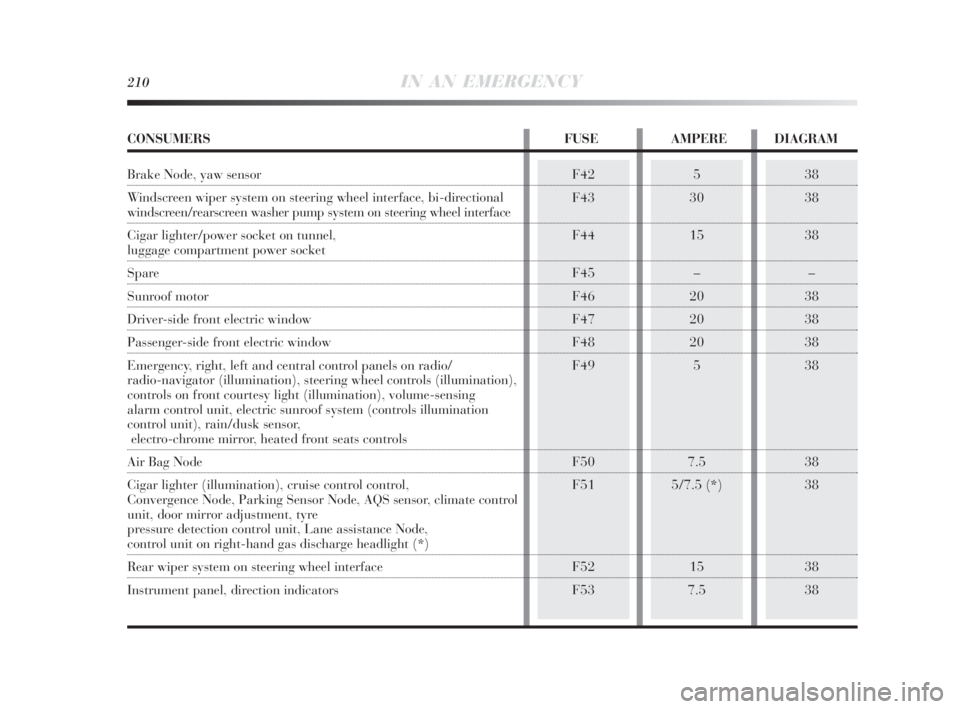
210IN AN EMERGENCY
38
38
38
–
38
38
38
38
38
38
38
38F42
F43
F44
F45
F46
F47
F48
F49
F50
F51
F52
F535
30
15
–
20
20
20
5
7.5
5/7.5 (*)
15
7.5
CONSUMERS FUSE AMPERE DIAGRAM
Brake Node, yaw sensor
Windscreen wiper system on steering wheel interface, bi-directional
windscreen/rearscreen washer pump system on steering wheel interface
Cigar lighter/power socket on tunnel,
luggage compartment power socket
Spare
Sunroof motor
Driver-side front electric window
Passenger-side front electric window
Emergency, right, left and central control panels on radio/
radio-navigator (illumination), steering wheel controls (illumination),
controls on front courtesy light (illumination), volume-sensing
alarm control unit, electric sunroof system (controls illumination
control unit), rain/dusk sensor,
electro-chrome mirror, heated front seats controls
Air Bag Node
Cigar lighter (illumination), cruise control control,
Convergence Node, Parking Sensor Node, AQS sensor, climate control
unit, door mirror adjustment, tyre
pressure detection control unit, Lane assistance Node,
control unit on right-hand gas discharge headlight (*)
Rear wiper system on steering wheel interface
Instrument panel, direction indicators
175-214 Delta 4ed gb 24-02-2010 14:36 Pagina 210
Page 212 of 276
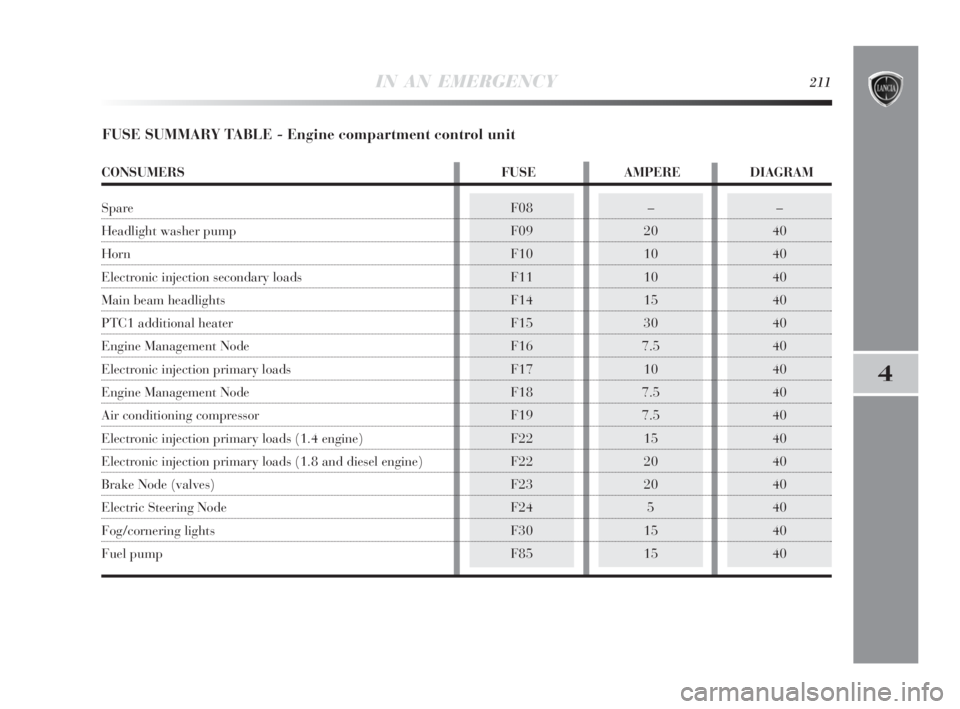
IN AN EMERGENCY211
4
–
40
40
40
40
40
40
40
40
40
40
40
40
40
40
40F08
F09
F10
F11
F14
F15
F16
F17
F18
F19
F22
F22
F23
F24
F30
F85–
20
10
10
15
30
7.5
10
7.5
7.5
15
20
20
5
15
15
FUSE SUMMARY TABLE - Engine compartment control unit
CONSUMERS FUSE AMPERE DIAGRAM
Spare
Headlight washer pump
Horn
Electronic injection secondary loads
Main beam headlights
PTC1 additional heater
Engine Management Node
Electronic injection primary loads
Engine Management Node
Air conditioning compressor
Electronic injection primary loads (1.4 engine)
Electronic injection primary loads (1.8 and diesel engine)
Brake Node (valves)
Electric Steering Node
Fog/cornering lights
Fuel pump
175-214 Delta 4ed gb 24-02-2010 14:36 Pagina 211
Page 215 of 276

214IN AN EMERGENCY
TOWING THE CAR
The tow ring provided with the car is housed in the tool
box under the luggage compartment mat.
FASTENING THE TOW RING fig. 43-44
Proceed as follows:
❍release cap A;
❍take the tow hook B from its seat in the tool support;
❍tighten the ring on the rear or front threaded pin.
fig. 43L0E0090mfig. 44L0E0091m
Before starting towing operations, turn the ig-
nition key to MAR and then to STOP, without
extracting it. If the key is extracted, the steer-
ing wheel lock will be automatically activated, thus
preventing steering. The power brakes and the elec-
trical power steering will not work while the car is be-
ing towed. More effort on the brake pedal and steer-
ing wheel will therefore be required. Do not use wires
for towing. Do not jerk. Make sure not to damage parts
in contact with the car while towing. Respect the spe-
cific rules of the Highway Code when towing the car
specifically in relation to the towing device and the be-
haviour to maintain on the road. Do not start the en-
gine while towing the car.
175-214 Delta 4ed gb 24-02-2010 14:36 Pagina 214
Page 218 of 276
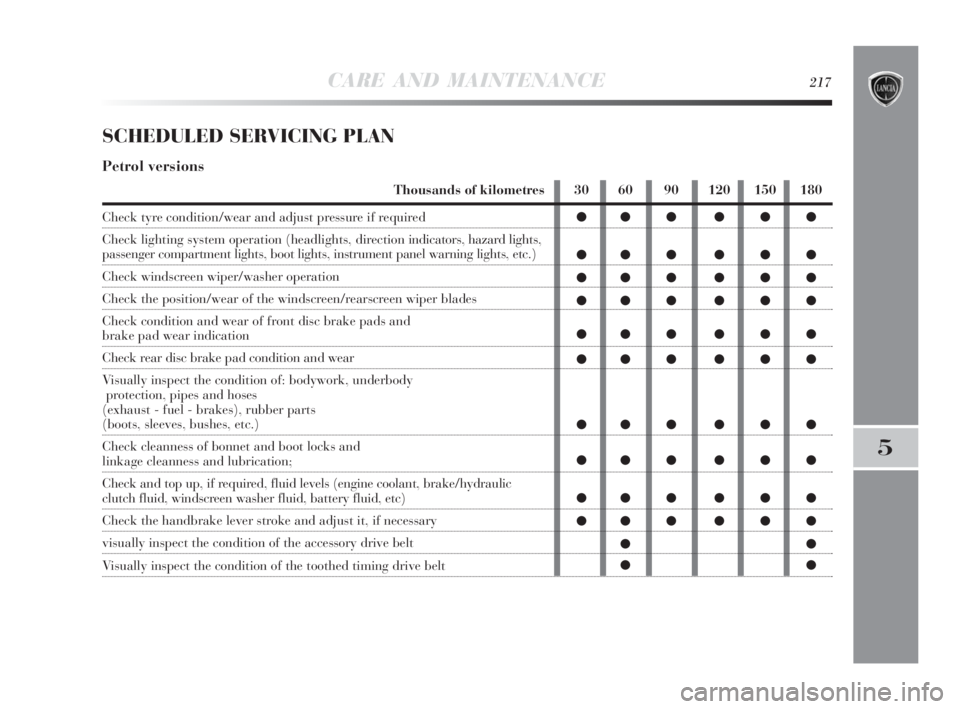
CARE AND MAINTENANCE217
5
SCHEDULED SERVICING PLAN
Petrol versions
Thousands of kilometres
Check tyre condition/wear and adjust pressure if required
Check lighting system operation (headlights, direction indicators, hazard lights,
passenger compartment lights, boot lights, instrument panel warning lights, etc.)
Check windscreen wiper/washer operation
Check the position/wear of the windscreen/rearscreen wiper blades
Check condition and wear of front disc brake pads and
brake pad wear indication
Check rear disc brake pad condition and wear
Visually inspect the condition of: bodywork, underbody
protection, pipes and hoses
(exhaust - fuel - brakes), rubber parts
(boots, sleeves, bushes, etc.)
Check cleanness of bonnet and boot locks and
linkage cleanness and lubrication;
Check and top up, if required, fluid levels (engine coolant, brake/hydraulic
clutch fluid, windscreen washer fluid, battery fluid, etc)
Check the handbrake lever stroke and adjust it, if necessary
visually inspect the condition of the accessory drive belt
Visually inspect the condition of the toothed timing drive belt30 60 90 120 150 180
●●● ●●●
●●● ●●●
●●● ●●●
●●● ●●●
●●● ●●●
●●● ●●●
●●● ●●●
●●● ●●●
●●● ●●●
●●● ●●●
●●
●●
215-242 Delta 3ed gb 11-11-2009 12:14 Pagina 217
Page 219 of 276
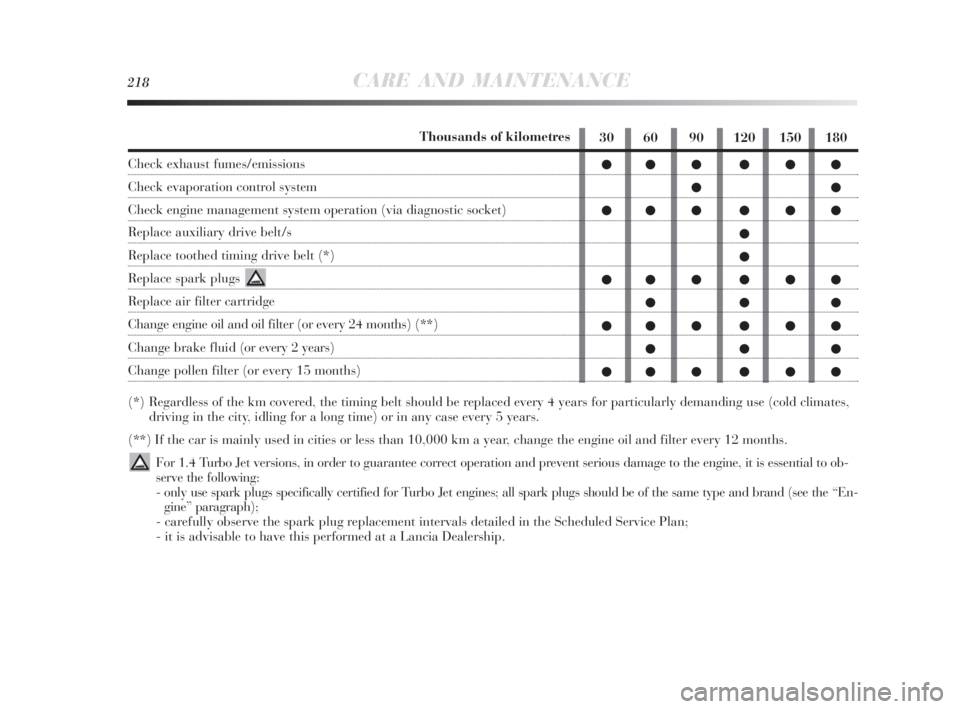
218CARE AND MAINTENANCE
30 60 90 120 150 180
●●● ●●●
●●
●●● ●●●
●
●
●●● ●●●
●●●
●●● ●●●
●●●
●●● ●●●Thousands of kilometres
Check exhaust fumes/emissions
Check evaporation control system
Check engine management system operation (via diagnostic socket)
Replace auxiliary drive belt/s
Replace toothed timing drive belt (*)
Replace spark plugs
Replace air filter cartridge
Change engine oil and oil filter (or every 24 months) (**)
Change brake fluid (or every 2 years)
Change pollen filter (or every 15 months)
(*) Regardless of the km covered, the timing belt should be replaced every 4 years for particularly demanding use (cold climates,
driving in the city, idling for a long time) or in any case every 5 years.
(**) If the car is mainly used in cities or less than 10,000 km a year, change the engine oil and filter every 12 months.
For 1.4 Turbo Jet versions, in order to guarantee correct operation and prevent serious damage to the engine, it is essential to ob-
serve the following:
- only use spark plugs specifically certified for Turbo Jet engines; all spark plugs should be of the same type and brand (see the “En-
gine” paragraph);
- carefully observe the spark plug replacement intervals detailed in the Scheduled Service Plan;
- it is advisable to have this performed at a Lancia Dealership.
215-242 Delta 3ed gb 11-11-2009 12:14 Pagina 218
Page 220 of 276
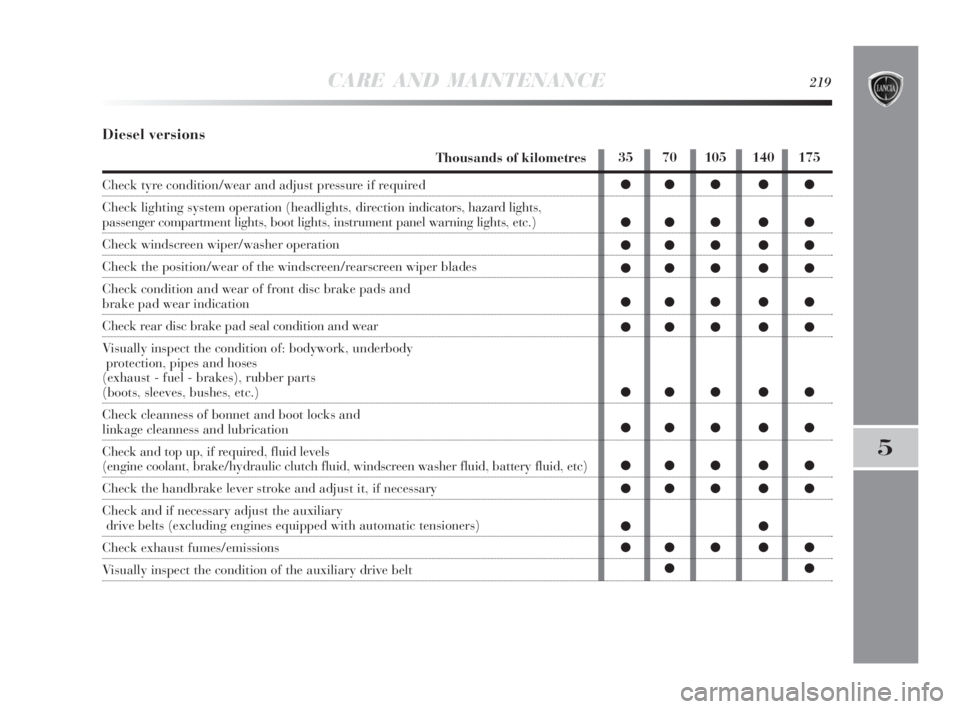
CARE AND MAINTENANCE219
5
Diesel versions
Thousands of kilometres
Check tyre condition/wear and adjust pressure if required
Check lighting system operation (headlights, direction indicators, hazard lights,
passenger compartment lights, boot lights, instrument panel warning lights, etc.)
Check windscreen wiper/washer operation
Check the position/wear of the windscreen/rearscreen wiper blades
Check condition and wear of front disc brake pads and
brake pad wear indication
Check rear disc brake pad seal condition and wear
Visually inspect the condition of: bodywork, underbody
protection, pipes and hoses
(exhaust - fuel - brakes), rubber parts
(boots, sleeves, bushes, etc.)
Check cleanness of bonnet and boot locks and
linkage cleanness and lubrication
Check and top up, if required, fluid levels
(engine coolant, brake/hydraulic clutch fluid, windscreen washer fluid, battery fluid, etc)
Check the handbrake lever stroke and adjust it, if necessary
Check and if necessary adjust the auxiliary
drive belts (excluding engines equipped with automatic tensioners)
Check exhaust fumes/emissions
Visually inspect the condition of the auxiliary drive belt35 70 105 140 175
●● ● ● ●
●● ● ● ●
●● ● ● ●
●● ● ● ●
●● ● ● ●
●● ● ● ●
●● ● ● ●
●● ● ● ●
●● ● ● ●
●● ● ● ●
●●
●● ● ● ●
●●
215-242 Delta 3ed gb 11-11-2009 12:14 Pagina 219
Page 221 of 276

35 70 105 140 175
●● ● ● ●
●
●
●●
●●
●● ● ● ●
●●
●● ● ● ●
220CARE AND MAINTENANCE
Thousands of kilometres
Check engine management system operation (via diagnostic socket)
Replace auxiliary drive belt
Replace toothed timing drive belt (*)
Replace fuel filter
Replace air filter cartridge
Change engine oil and oil filter (versions without DPF) (or every 24 months)
Change engine oil and oil filter (versions with DPF) (**)
Change brake fluid (or every 24 months)
Change pollen filter (or every 15 months)
(*) Regardless of the km covered, the timing belt should be replaced every 4 years for particularly demanding use (cold climates,
driving in the city, idling for a long time) or in any case every 5 years.
(**) The engine oil and the filter must be changed when the instrument panel warning light comes on (see “Warning lights and
Messages” chapter) and in all cases every 2 years.
If the car is used mainly in towns the engine oil and filter need to be changed every 12 months.
215-242 Delta 3ed gb 11-11-2009 12:14 Pagina 220
Page 222 of 276
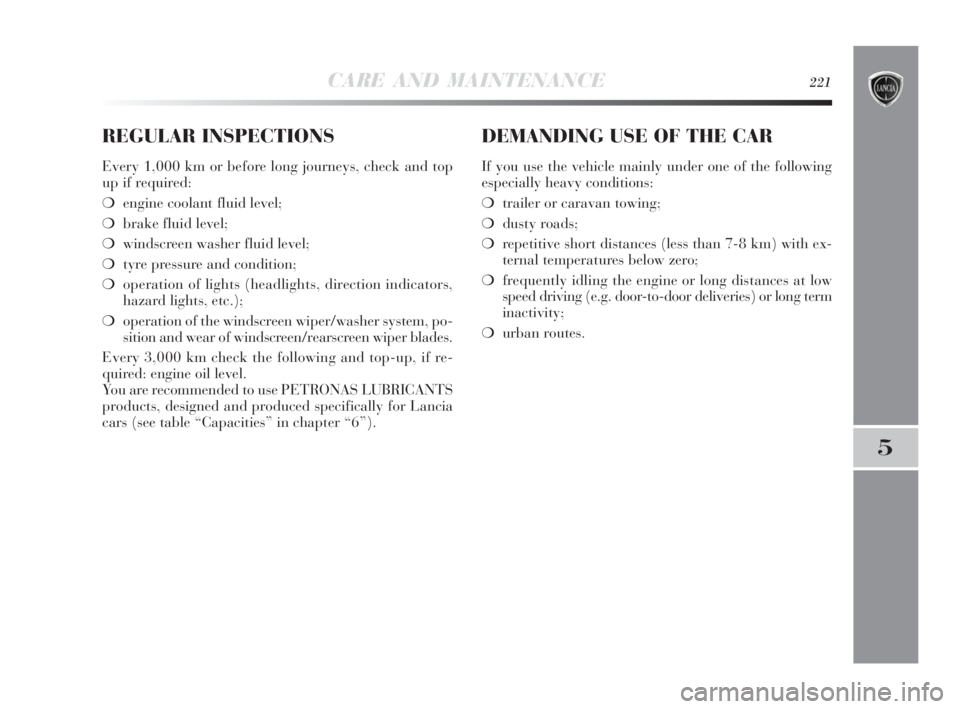
CARE AND MAINTENANCE221
5
REGULAR INSPECTIONS
Every 1,000 km or before long journeys, check and top
up if required:
❍engine coolant fluid level;
❍brake fluid level;
❍windscreen washer fluid level;
❍tyre pressure and condition;
❍operation of lights (headlights, direction indicators,
hazard lights, etc.);
❍operation of the windscreen wiper/washer system, po-
sition and wear of windscreen/rearscreen wiper blades.
Every 3,000 km check the following and top-up, if re-
quired: engine oil level.
You are recommended to use PETRONAS LUBRICANTS
products, designed and produced specifically for Lancia
cars (see table “Capacities” in chapter “6”).
DEMANDING USE OF THE CAR
If you use the vehicle mainly under one of the following
especially heavy conditions:
❍trailer or caravan towing;
❍dusty roads;
❍repetitive short distances (less than 7-8 km) with ex-
ternal temperatures below zero;
❍frequently idling the engine or long distances at low
speed driving (e.g. door-to-door deliveries) or long term
inactivity;
❍urban routes.
215-242 Delta 3ed gb 11-11-2009 12:14 Pagina 221
Page 223 of 276
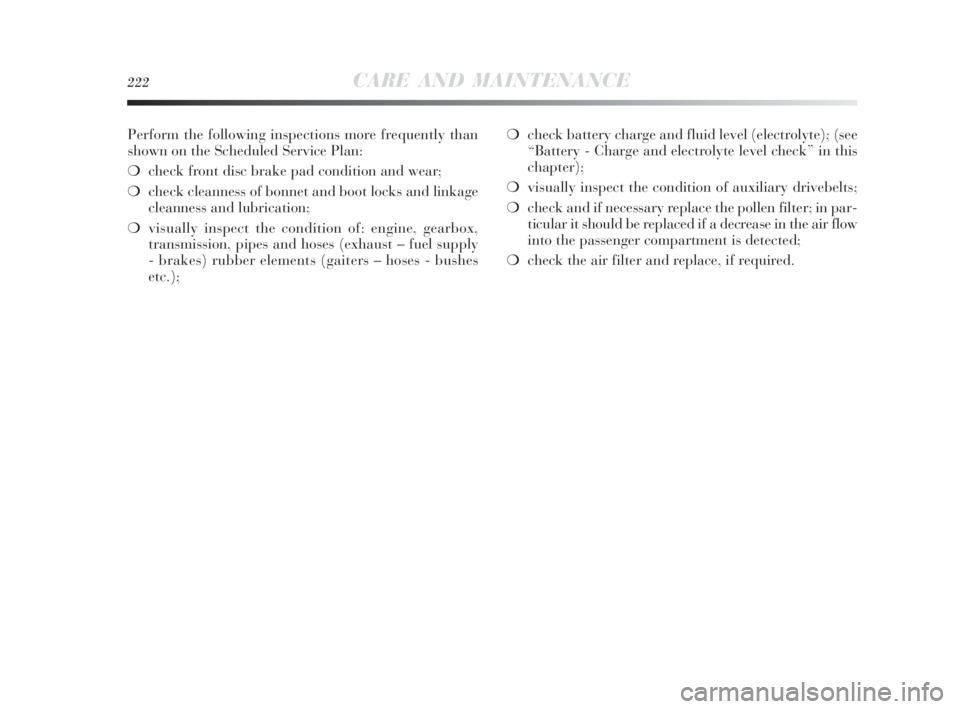
222CARE AND MAINTENANCE
Perform the following inspections more frequently than
shown on the Scheduled Service Plan:
❍check front disc brake pad condition and wear;
❍check cleanness of bonnet and boot locks and linkage
cleanness and lubrication;
❍visually inspect the condition of: engine, gearbox,
transmission, pipes and hoses (exhaust – fuel supply
- brakes) rubber elements (gaiters – hoses - bushes
etc.);❍check battery charge and fluid level (electrolyte); (see
“Battery - Charge and electrolyte level check” in this
chapter);
❍visually inspect the condition of auxiliary drivebelts;
❍check and if necessary replace the pollen filter; in par-
ticular it should be replaced if a decrease in the air flow
into the passenger compartment is detected;
❍check the air filter and replace, if required.
215-242 Delta 3ed gb 11-11-2009 12:14 Pagina 222
Page 229 of 276
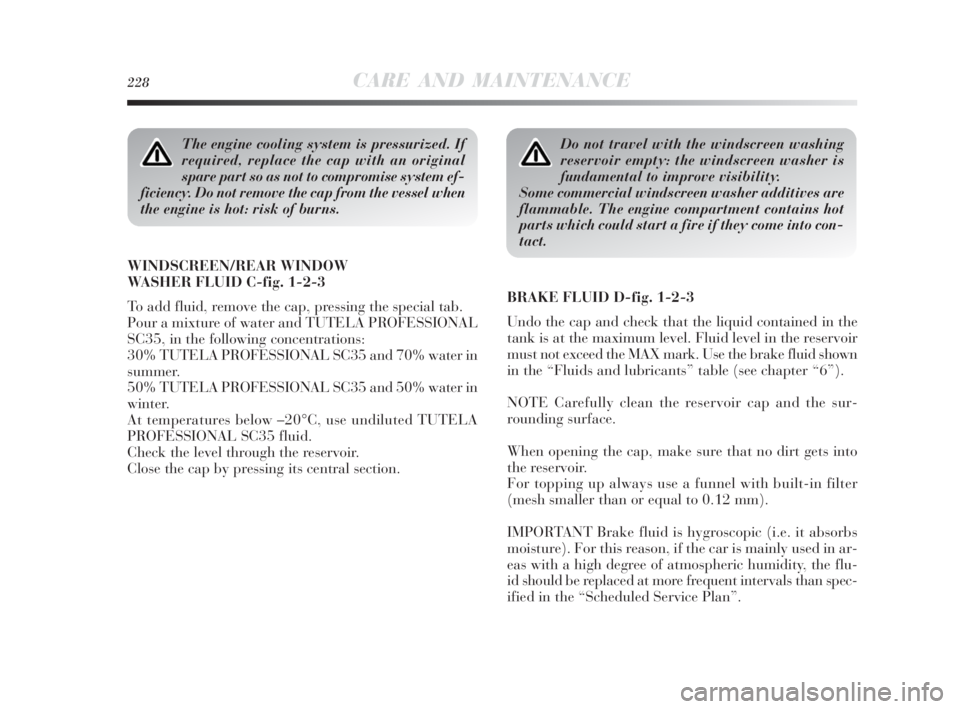
228CARE AND MAINTENANCE
The engine cooling system is pressurized. If
required, replace the cap with an original
spare part so as not to compromise system ef-
ficiency. Do not remove the cap from the vessel when
the engine is hot: risk of burns.
WINDSCREEN/REAR WINDOW
WASHER FLUID C-fig. 1-2-3
To add fluid, remove the cap, pressing the special tab.
Pour a mixture of water and TUTELA PROFESSIONAL
SC35, in the following concentrations:
30% TUTELA PROFESSIONAL SC35 and 70% water in
summer.
50% TUTELA PROFESSIONAL SC35 and 50% water in
winter.
At temperatures below –20°C, use undiluted TUTELA
PROFESSIONAL SC35 fluid.
Check the level through the reservoir.
Close the cap by pressing its central section.
Do not travel with the windscreen washing
reservoir empty: the windscreen washer is
fundamental to improve visibility.
Some commercial windscreen washer additives are
flammable. The engine compartment contains hot
parts which could start a fire if they come into con-
tact.
BRAKE FLUID D-fig. 1-2-3
Undo the cap and check that the liquid contained in the
tank is at the maximum level. Fluid level in the reservoir
must not exceed the MAX mark. Use the brake fluid shown
in the “Fluids and lubricants” table (see chapter “6”).
NOTE Carefully clean the reservoir cap and the sur-
rounding surface.
When opening the cap, make sure that no dirt gets into
the reservoir.
For topping up always use a funnel with built-in filter
(mesh smaller than or equal to 0.12 mm).
IMPORTANT Brake fluid is hygroscopic (i.e. it absorbs
moisture). For this reason, if the car is mainly used in ar-
eas with a high degree of atmospheric humidity, the flu-
id should be replaced at more frequent intervals than spec-
ified in the “Scheduled Service Plan”.
215-242 Delta 3ed gb 11-11-2009 12:14 Pagina 228